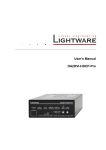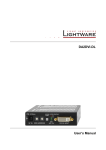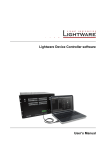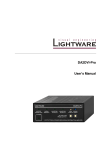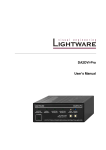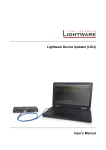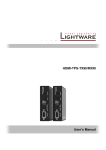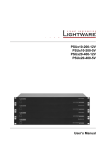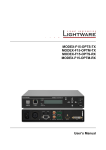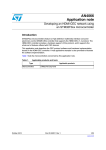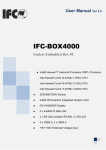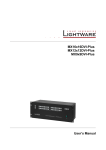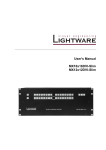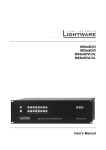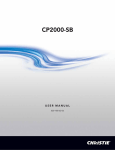Download DA2DVI-HDCP-Pro User`s manual
Transcript
DA2DVI-HDCP-Pro User’s Manual DA2DVI-HDCP-Pro User’s Manual SAFETY INSTRUCTIONS Class II apparatus construction. This equipment should be operated only from power source indicated on the product. To disconnect safely from power, remove the power cord from the rear of the equipment, or from the power source. The MAINS plug is used as the disconnect device, the disconnect device shall remain readily operable. There are no user-serviceable parts inside of the unit. Removal of the bottom cover will expose dangerous voltages. To avoid personal injury, do not remove the bottom cover. Do not operate the unit without the cover installed. The apparatus shall not be exposed to dripping or splashing and that no objects filled with liquids, such as vases, shall be placed on the apparatus. The apparatus must be safely connected to multimedia systems. Follow instructions described in this manual. WEEE ( W as te E l e c tr ic a l & E lec tr on ic Eq u ipm en t ) Correct Disposal of This Product This marking shown on the product or its literature, indicates that it should not be disposed with other household wastes at the end of its working life. To prevent possible harm to the environment or human health from uncontrolled waste disposal, please separate this from other types of wastes and recycle it responsibly to promote the sustainable reuse of material resources. Household users should contact either the retailer where they purchased this product, or their local government office, for details of where and how they can take this item for environmentally safe recycling. Business users should contact their supplier and check the terms and conditions of the purchase contract. This product should not be mixed with other commercial wastes for disposal. Section 1. Introduction Page 3 / 36 DECLARATION OF CONFORMITY We, Lightware Kft. 1071 Budapest Peterdy str. 15 HUNGARY as manufacturer declare, that the products DA2DVI-HDCP-Pro ( DVI Distribution Amplifier ) in accordance with the EMC Directive 2004/108/EC and the Low Voltage Directive 2006/95/EEC are in conformity with the following standards: EMI/EMC Safety EN 55022 Class B UL, CUL, GS, CR, RCM, PSE, Class II Date: 01 August 2011 Name: Gergely Vida ( Managing Director ) Signed: Page 4 / 36 Section 1. Introduction DA2DVI-HDCP-Pro User’s Manual Table of contents 1. INTRODUCTION ...................................................................................................................... 7 1.1. BOX CONTENTS................................................................................................................... 7 1.2. DESCRIPTION...................................................................................................................... 7 1.3. EXTENDER FEATURES ......................................................................................................... 7 1.4. TYPICAL APPLICATIONS ....................................................................................................... 8 1.4.1. EDID management ................................................................................................... 8 1.4.2. Cascading multiple DA2DVI-HDCP-Pros ................................................................. 8 2. CONTROLS AND CONNECTIONS......................................................................................... 9 2.1. FRONT VIEW ....................................................................................................................... 9 2.2. REAR VIEW ....................................................................................................................... 10 2.3. ELECTRICAL CONNECTIONS ............................................................................................... 10 2.3.1. DVI connectors ....................................................................................................... 10 2.3.2. DC +5V connection ................................................................................................. 11 3. TECHNOLOGIES................................................................................................................... 12 3.1. 3.2. 3.3. 3.4. 3.5. 4. OPERATION .......................................................................................................................... 15 4.1. 4.2. 4.3. 4.4. 4.5. 5. UNDERSTANDING EDID..................................................................................................... 12 COMMON PROBLEMS RELATED TO EDID ............................................................................ 12 ADVANCED EDID MANAGEMENT........................................................................................ 13 FIBER CABLE POWERING ................................................................................................... 13 PIXEL ACCURATE RECLOCKING ......................................................................................... 14 POWERING ON .................................................................................................................. 15 ABOUT EDID MEMORY ...................................................................................................... 16 SWITCHING THE EDID ....................................................................................................... 17 LEARNING THE EDID......................................................................................................... 17 HDCP MANAGEMENT ........................................................................................................ 18 SOFTWARE CONTROL – USING LIGHTWARE DEVICE CONTROLLER ......................... 19 5.1. STEPS OF THE INSTALLATION IN CASE OF W INDOWS OS...................................................... 19 5.2. STEPS OF THE INSTALLATION IN CASE OF MAC OS X ........................................................... 21 5.3. LDC UPGRADE ................................................................................................................. 22 5.4. ESTABLISHING THE CONNECTION ....................................................................................... 23 5.5. I/O PARAMETERS MENU .................................................................................................... 23 5.5.1. Port Properties (input) ............................................................................................. 23 5.5.2. Port Properties (output)........................................................................................... 24 5.6. EDID MENU ...................................................................................................................... 25 5.6.1. Sources and Destinations ....................................................................................... 25 5.6.2. Changing the emulated EDID ................................................................................. 26 5.6.3. Learning an EDID ................................................................................................... 26 5.6.4. Exporting an EDID .................................................................................................. 26 5.6.5. Importing an EDID .................................................................................................. 26 5.6.6. Deleting EDID(s) ..................................................................................................... 27 5.6.7. Creating an EDID .................................................................................................... 27 5.6.8. EDID Summary window .......................................................................................... 28 5.6.9. Editing an EDID ...................................................................................................... 28 5.7. SETTINGS MENU................................................................................................................ 29 5.7.1. Device information tab ............................................................................................ 29 5.7.2. Log tab .................................................................................................................... 29 5.8. TERMINAL ......................................................................................................................... 30 5.9. DEVICE DISCOVERY (INFORMATION RIBBON) ....................................................................... 30 6. FIRMWARE UPGRADE – USING LIGHTWARE BOOTLOADER ....................................... 31 7. TROUBLESHOOTING ........................................................................................................... 33 7.1. 7.2. 7.3. GENERAL PROBLEMS......................................................................................................... 33 PICTURE IS NOT DISPLAYED OR DISTORTED ........................................................................ 33 HDCP ISSUES .................................................................................................................. 33 Section 1. Introduction Page 5 / 36 8. SPECIFICATIONS ................................................................................................................. 34 9. SPECIFICATIONS ................................................................................................................. 34 9.1. MECHANICAL DRAWINGS.................................................................................................... 35 10. VERSION APPLICABILITY ................................................................................................... 36 11. WARRANTY .......................................................................................................................... 36 12. DOCUMENT REVISION HISTORY ....................................................................................... 36 Page 6 / 36 Section 1. Introduction DA2DVI-HDCP-Pro User’s Manual 1. Introduction Thank you for choosing Lightware DA2DVI-HDCP-Pro, the two output professional DVI distribution amplifier supporting HDCP encryption and HDMI 1.3a compliant signals. 1.1. Box contents DA2DVI-HDCP-Pro unit +12V DC adaptor with interchangeable plugs Quick Start Guide 1.2. Description Lightware DA2DVI-HDCP-Pro is a multifunctional distribution amplifier with built-in EDID Management and Pixel Accurate Reclocking, supporting DVI and HDMI 1.3a signals with or without HDCP encryption. It automatically compensates for up to 60 meters of DVI copper cable, hence no adjustment is needed by the user. The Output signal is reclocked and stabilized using Lightware's Pixel Accurate Reclocking technology to remove jitter caused by long cables or poor quality DVI sources. Thanks to the Advanced EDID Management, DA2DVI-HDCP-Pro can emulate any DVI or HDMI display for continuous video output, even if the attached display is disconnected or powered down. The EDID memories from 01 to 49 are factory presets, the memories from 51 to 98 are user programmable. Memory 00 is transparent for OUTPUT 1 and Memory 99 is for OUTPUT 2, which means that the attached display device's EDID (monitor or projector) will be reported to the source. With the Easy EDID Creator (PC software) the users can create their own EDID by completing four simple steps. More experienced users can use the Advanced EDID Editor software to manage every possible setting in the EDID, which they can upload to the memory of the DA2DVI-HDCP-Pro. DA2DVI-HDCP-Pro can be rack mounted or used standalone. The unit is equipped with the highest grade gold plated connectors to ensure reliable connection. 1.3. Extender features Advanced EDID Management – The user can emulate any EDID on the device's input by using the 49 factory or 48 user presets. Any attached monitor's EDID can be read out, edited and stored as user presets by the Lightware Device Controller Software. 60 meter input cable compensation – Using 22AWG high quality DVI cable, the input is automatically compensated for up to 60 meter cable length, which extends installation possibilities even on highest HDTV or computer resolutions. In case of lower pixel resolutions, this length can be even higher. Pixel Accurate Reclocking – Removes jitter and skew caused by long cable, each output has a clean, jitter free signal, eliminating signal instability and distortion caused by long cables or connector reflections. Various status indicator LEDs – See the status of the device in one second: Section 1. Introduction Source +5V Input signal present, HDCP status, Monitor 1 and 2 hotplug, EDID emulation status, Power LED. Page 7 / 36 Front panel control – EDID address selection with two decimal rotary switches, Learn EDID button are available for Advanced EDID Management. USB control – DA2DVI-HDCP-Pro is controllable via the Lightware Device Controller software. Advanced EDID Management and firmware upgrades are available. Supports all HDTV resolutions – Supports HDCP encrypted and unencrypted HDTV signals up to 225 MHz pixel clock frequency regardless of the resolution being passed through. (720p, 1080i and 1080p etc.) Fiber cable support – Self-powered DVI fiber cables using +5V from DVI sources (VGA cards, etc.) usually consuming more than 50 mA (maximum suggested by DVI 1.0 standard). Lightware devices support +5V 500 mA constant current output on the DVI outputs to power long distance fiber optical cables. Universal power supply – DA2DVI-HDCP-Pro is supplied with a universal +5V power adaptor, which accepts AC voltages from 100 to 240 Volts with 50 or 60 Hz line frequency. 1.4. Typical applications 1.4.1. EDID management To be compatible with various end-points in an AV system, the common EDID can be selected by the DA2DVI-HDCP-Pro. For more information see section 3.1 on page 12. Figure 1-1. EDID emulation 1.4.2. Cascading multiple DA2DVI-HDCP-Pros Thanks to the built-in cable equalizer and the Pixel Accurate Reclocking circuit, up to 6 DA2DVI-HDCP-Pro units can be cascaded. This feature is especially useful for digital signage applications. The distance between the display blocks may be up to 60 meters in case of HD 1080p resolution, or even higher for lower pixel numbers or interlaced scan 1080i. If the display devices have different resolutions, please emulate the EDID of the display that has the lowest resolution, otherwise the displays with higher resolutions may not show the whole image, rescale the image or won’t display an image at all. Figure 1-2. Daisy-chain application Page 8 / 36 Section 1. Introduction DA2DVI-HDCP-Pro User’s Manual 2. Controls and connections 2.1. Front view Status LEDs 1 2 USB Control 4 Power LED 3 1 Status LEDs Learn button 5 Rotary switches Source +5V: Indicates if +5V power signal is sent to pin 14 of the INPUT connector by the DVI source (PC, Laptop, etc). Signal present: Indicates if a valid DVI clock signal is present on the INPUT connector. Slow blinking appears if HDMI signal is present on INPUT and OUTPUT port and fast blinking indicates HDMI to DVI conversion. To turn ON/OFF HDMI to DVI conversion see section 4.4 on page 17. HDCP active: Indicates the source signal’s HDCP encryption. Blinking green LED indicates the HDCP OFF function (use LDC software to enable/disable HDCP compliant operation). For more information see section 4.5 on page 18. Monitor hotplug: Indicates if a powered display device (or matrix switcher, repeater, etc.) is connected to the OUTPUT connector and sends a valid hotplug signal on pin 16 through the DVI cable. EDID Status: o EDID status: The LED stays green if the selected EDID is valid or it turns red, if the selected EDID is invalid. o FW version display: During startup it displays the firmware version. o EDID read status: The LED indicates that the unit is reading the EDID from the connected display. If the LED is blinking green then the EDID is valid, if blinking red, then the EDID is invalid or missing. This function is available for either OUTPUT and saves the EDID to the Last attached Monitor’s EDID memory. o Learn process: The LED indicates if the EDID learn process was successful (blinking green) or not (blinking red). o Firmware upgrade: The LED blinks red and green during the upgrade. 2 Learn button Stores the EDID of the display device attached to OUTPUT 1 in the selected memory address. To learn the EDID, select an appropriate address with the rotary switches and press and hold the LEARN button for three seconds. For more information see chapter 4 on page 15. 3 Power LED Indicates if the device is powered on. 4 USB control Further EDID settings and firmware upgrade are available via the USB interface. 5 Rotary switches The rotary switches select one of the EDID memory addresses. For more information see section 4.2 on page 16. Section 2. Controls and connections Page 9 / 36 2.2. Rear view 3 Output1 3 Output2 DC +5V in 1 2 Input 1 DC +5V in Connect the OUTPUT of the supplied +5V power adaptor. The Power LED indicates the proper supply voltage. 2 Input Connect one Single-Link DVI cable (only digital pins are connected internally) between the DVI source and DA2DVI-HDCP-Pro. See more information in section 2.3.1 on page 10. 3 Outputs Connect one Single-Link DVI-D or DVI-I cable (only digital pins are connected internally) between DA2DVI-HDCP-Pro and display device. The OUTPUT connector is able to supply 500 mA current on pin 14 to power fiber optical DVI extenders like DVI-OPT-TX110. See more information in section 2.3.1 on page 10. 2.3. Electrical connections 2.3.1. DVI connectors DA2DVI-HDCP-Pro provides 29 pole „digital only” DVI-I connectors (only digital pins are internally connected). This way, users can plug in any DVI connector, but keep in mind that analog signals (such as VGA or RGBHV) are not processed. Always use high quality DVI cable for connecting sources and displays. 1 2 3 4 5 6 7 8 C1 C2 9 10 11 12 13 14 15 16 17 18 19 20 21 22 23 24 C3 C4 C5 Pin Signal Pin Signal Pin Signal 1 TMDS Data2- 9 TMDS Data1- 17 TMDS Data0- 2 TMDS Data2+ 10 TMDS Data1+ 18 TMDS Data0+ 3 TMDS Data2 Shield 11 TMDS Data1 Shield 19 TMDS Data0 Shield 4 nc 12 nc 20 nc 5 nc 13 nc 21 nc 6 DDC Clock 14 +5V Power 22 TMDS Clock Shield 7 DDC Data 15 GND (for +5V) 23 TMDS Clock+ 8 nc 16 Hot Plug Detect 24 TMDS Clock- C1 nc C2 nc C3 nc C4 nc C5 GND Table 2-1. DVI-I Single Link digital only connector pin assignments Page 10 / 36 Section 2. Controls and connections DA2DVI-HDCP-Pro User’s Manual DVI output Monitor hotplug is detected on the OUTPUT ports (Monitor hotplug LED lights green). After a hotplug event, the DA2DVI-HDCP-Pro tries to read the EDID of the connected device. Fiber Cable powering As a special feature, the device is able to supply 500 mA current on DDC +5V output (pin 14 on OUTPUT connector) to power fiber optical DVI transmitters. Standard DVI outputs or VGA cards supply only 55 mA current on +5V output, thus unable to power directly a fiber optical cable. Info: The device does not check if the connected sink (monitor, projector or other equipment) supports hotplug or EDID signals but outputs the input signal directly. DVI input The input has a built-in signal detection circuit with a LED indicator. The DVI Signal present LED lights green, if the INPUT connector senses an active DVI signal. Cable length at inputs The unit has an advanced built-in cable equalization circuit, which automatically provides cable length compensation. This circuit extends the maximum usable cable length to 60 meters using high quality 22AWG copper cable at WUXGA 1920x1200 graphics resolution. 22 AWG 24 AWG Reference type DVI GEAR: SHR DVI Reference type TASKER: TSK 1060 Resolution Max length (meter) Max length (meter) 1920x1200; 1600x1200; 2048x1080p; 1080p 60 m 50 m 75 m 62 m 92 m 77 m 100 m (calculated) 120 m (calculated) 84 m (calculated) 100 m (calculated) Cable type Signal 1680x1050; 1400x1050; 1280x1024 1024x768; 1365x768; 720p; 1080i; 800x600 640x480; 480p; 576p Table 2-2. Maximum DVI cable lengths at inputs 2.3.2. DC +5V connection The device has a locking DC connector to establish robust and safe power connection. After plugging it in, turn the plug clockwise as you can see in the picture below. Figure 2-1. Locking DC connector Do not forget to turn the connector counterclockwise before trying to disconnect the power adaptor. Warranty void if damage occurs due to use of a different power source. Always use the supplied +5V power adaptor or Lightware’s rack mountable power supply. Section 2. Controls and connections Page 11 / 36 3. Technologies 3.1. Understanding EDID EDID stands for Extended Display Identification Data. Simply put, EDID is the passport of display devices (monitors, TV sets, projectors). It contains information about the display’s capabilities, such as supported resolutions, refresh rates (these are called Detailed Timings), the type and manufacturer of the display device, etc. After connecting a DVI source to a DVI display, the source reads out the EDID to determine the resolution and refresh rate of the image to be transmitted. Who are you? PC or Mac Display I am a monitor. Here is my EDID. PC or Mac Display Now I know what I can send. PC or Mac Display Figure 3-1. EDID communication Most DVI computer displays have 128-byte long EDID structure. However, Digital Televisions and HDMI capable displays may have another 128 bytes, which is called EEDID and defined by CEA (Consumer Electronics Association). This extension contains information about additional Detailed Timings, audio capabilities, speaker allocation and HDMI capabilities. It is important to know, that all HDMI capable devices must have CEA extension, but not all devices are HDMI capable which have the extension. 3.2. Common problems related to EDID Problem: „My system consists of the following: a computer, a Lightware DA2DVI-HDCPPro distribution amplifier, a WUXGA (1920x1200) LCD monitor, and a SXGA (1280x1024) projector. I would like to see the same image on the monitor and the projector. What EDID should I chose on the router?” Solution: If you want to see the image on both displays, you need to select the resolution of the smaller display (in this case SXGA); otherwise the smaller display may not show the higher resolution image. Problem: „I have changed the EDID on the input to have a different resolution but nothing happens.” Solution: Page 12 / 36 Some graphics cards and video sources read out the EDID only after power-up and later they don’t sense that EDID has been changed. You need to restart your source to make it read out the EDID again. Section 3. Technologies DA2DVI-HDCP-Pro User’s Manual Problem: „My source allows only one resolution to select when I use a Lightware factory preset EDID on the input port. I would like to be able to choose from different resolutions.” Solution: Most Lightware factory preset EDIDs allow only one resolution, forcing the sources to OUTPUT only that particular signal. You need to select the Universal EDID, it supports all common VESA resolutions. Additionally it also features audio support. 3.3. Advanced EDID Management Each DVI/HDMI sink (e.g. monitors, projectors, plasma displays, and switcher inputs) must support the EDID data structure. Source BIOS and operating systems are likely to query the sink using DDC2B protocol to determine what pixel formats and interface are supported. DVI/HDMI standard makes use of EDID data structure for the identification of the monitor type and capabilities. Most DVI/HDMI sources (VGA cards, set top boxes, etc) will output DVI/HDMI signal after accepting the connected sink’s EDID information. In case of EDID readout failure or missing EDID the source will not output DVI video signal. DA2DVI-HDCP-Pro provides Lightware’s Advanced EDID Management function which helps system integration. The DA2DVI-HDCP-Pro stores and emulates 97 EDID data plus the EDID of the last attached monitor connected to the OUTPUT. First 49 EDID are factory presets, while memories #51..#98 are user programmable. The device stores the EDIDs in non-volatile memory. This way the EDID from the monitor is available when the monitor is unplugged, or switched off. The EDID emulated on the INPUT can be copied from the DA2DVI-HDCP-Pro's memory (static EDID emulation) or from the attached monitor (dynamic EDID emulation). For example, the DA2DVI-HDCP-Pro can be set up to emulate the device, which is connected to OUTPUT, and the EDID automatically changes, if the monitor is replaced with another display device (as long as it has a valid EDID). Info: The user is not required to disconnect the DVI cable to change an EDID as opposed to other manufacturer’s products. EDID can be changed even if source is connected to the INPUT and powered ON. Info: When the emulated EDID has been changed, the device toggles the HOTPLUG signal for 2 seconds. Some sources do not observe this signal, so in this case the change is not recognized by the source. In such cases the source device must be restarted or powered OFF and ON again. Info: If a new sink device (monitor) is connected while HDCP is enabled, the DA2DVI-HDCPPro virtually reconnects the source device to ensure HDCP functionality. This may cause the picture disappear for a few seconds. 3.4. Fiber Cable powering As a special feature DA2DVI-HDCP-Pro is able to supply 500 mA current to power fiber optical transmitters like DVI-OPT-TX110 (Pin 14 on both OUTPUT connectors). Standard DVI outputs or VGA cards supply only 55 mA current on +5V output, thus unable to directly power a fiber optical cable. Info: DA2DVI-HDCP-Pro does not check if the connected sink (monitor, projector or other equipment) supports Hotplug or EDID signals but outputs the signal immediately after it has been applied to the INPUT. Section 3. Technologies Page 13 / 36 3.5. Pixel Accurate Reclocking DA2DVI-HDCP-Pro reclocks the signal on all outputs using Lightware’s sophisticated Pixel Accurate Reclocking technology. Signal reclocking is an essential important procedure in digital signal transmission. After passing the reclocking circuit, the signal becomes stable and jitter-free, and can be transmitted over more equipment like processors, or event controllers. Without reclocking, sparkles, noise and jaggies can be seen on the image. The Pixel Accurate Reclocking circuit eliminates the following errors: Intra-pair skew: skew between the + and - wires within a differential wire pair (e.g. Data2and Data2+). It’s caused by different wire lengths or slightly different wire construction (impedance mismatch) in DVI cable. It results in jitter. + Intra-pair skew Inter-pair skew: skew between two differential wire pairs in a cable. It’s caused by different wire pair lengths or different number of twists in the DVI cable. Too much inter-pair skew results in color shift in the picture or sync loss. + + Inter-pair skew Jitter: signal instability in the time domain. The time difference between two signal transitions should be a fix value, but noise and other effects cause variations. + Jitter Noise: electromagnetic interference between other electronic devices such as mobile phones, motors, etc. and the DVI cable are coupled onto the signal. Too much noise results in increased jitter. + Noise The Pixel Accurate Reclocking circuit completely regenerates the original video signal and outputs a strong, high-quality digital signal that conforms to the DVI specification. Page 14 / 36 Section 3. Technologies DA2DVI-HDCP-Pro User’s Manual 4. Operation 4.1. Powering on Info: When building an electronic system, make sure that all of the devices are powered down before connecting them. Powered on devices may have dangerous voltage levels that can damage sensitive electronic circuits. Step 1. After the system is complete, connect the OUTPUT of the +5V power adaptor to the DA2DVI-HDCP-Pro. The unit is immediately powered ON. Step 2. After the DA2DVI-HDCP-Pro is initialized, the attached DVI source and monitor can be powered on. Startup process Step 1. After being powered on, the DA2DVI-HDCP-Pro displays its firmware version using the Status LED. The following example shows this process for a firmware version of 1.1.8 Red blinks once → Short pause → Green blinks once → Short pause → Green blinks eight times Step 2. After indicating the firmware version, the Status LED turns green if the selected EDID is valid, or turns red, if the selected EDID is invalid. Step 3. If a display device is connected to an OUTPUT, the DA2DVI-HDCP-Pro reads the EDID from the attached monitor’s EDID memory. Step 4. The normal function of the LED is in effect. Info: If none of the LEDs light up upon power-up, the unit is most likely damaged and further use is not advised. Please contact [email protected] DA2DVI-HDCP-Pro ensures HDCP functionality, when the HDCP pass-through is enabled. If a new sink device (monitor) is connected while HDCP is enabled, the DA2DVI-HDCPPro virtually reconnects the source device to ensure HDCP functionality. Switching the Hotplug signal off and on again indicates to the source device, that the sink is ready to communicate. This may cause the picture disappear for a few seconds. If HDCP pass-through is disabled, connecting or reconnecting a display device does not affect the input. This way the signal on the OUTPUT will be continuous. If HDCP is not necessary turn off the HDCP pass-through. For more information see section 4.5 on page 18. Section 4. Operation Page 15 / 36 4.2. About EDID memory Lightware factory preloaded EDIDs are specially provided to force graphic cards to output only the exact pixel resolution and refresh rate. Universal EDID (address 49#) allows multiple resolutions including all common VESA defined resolutions. In addition, it also features audio support. The use of universal EDID is advised for fast and easy system setup. DA2DVI-HDCP-Pro contains a 97 block non-volatile memory bank. EDID memory is structured as follows: Rotary switch state Memory bank number #01..#49 ................................. F01..F49 ............................ Factory Preset EDID list #51..#98 ................................ U01..U48 .......................... User programmable slots #00 and #99 ....................... D01 and D99 ............... Last attached monitor’s EDID Info: Address #50 is reserved. Info: The Factory Preset EDID list cannot be modified. These are the most commonly used resolutions. Info: The device can handle both 128 Byte EDID and 256 Byte extended EDID structures. Info: The attached monitor’s EDID is stored automatically, until a new monitor is connected to the OUTPUT. In case of powering the unit off, the last attached monitor’s EDID remains in non-volatile memory. MEM #01 #02 #03 #04 #05 #06 #07 #08 #09 #10 #11 #12 #13 #14 #15 #16 #17 #18 #19 #20 #21 #22 #23 #24 #25 #26 Resolution 640 x 480 640 x 480 848 x 480 800 x 600 800 x 600 800 x 600 1024 x 768 1024 x 768 1024 x 768 1152 x 864 1280 x 768 1280 x 768 1280 x 768 1360 x 768 1364 x 768 1364 x 768 1364 x 768 1280 x 1024 1280 x 1024 1280 x 1024 1366 x 1024 1400 x 1050 1400 x 1050 1400 x 1050 1680 x 1050 1600 x 1200 @ 60.0 Hz @ 75.0 Hz @ 60.0 Hz @ 50.0 Hz @ 60.30 Hz @ 74.99 Hz @ 49.98 Hz @ 60.0 Hz @ 75.2 Hz @ 75.0 Hz @ 50.0 Hz @ 59.92 Hz @ 75.0 Hz @ 60.1 Hz @ 50.0 Hz @ 59.93 Hz @ 74.98 Hz @ 50.0 Hz @ 60.1 Hz @ 75.1 Hz @ 59.99 Hz @ 49.99 Hz @ 59.99 Hz @ 75.0 Hz @ 59.99 Hz @ 50.0 Hz MEM Resolution #27 1600 x 1200 @ 60.0 Hz 1920 x 1200 @ 59.55 Hz 1920 x 1200 @ 50.0 Hz 1440 x 480i @ 60.3 Hz * 640 x 480 @ 59.94 Hz * 720 x 480 @ 59.92 Hz * 1440 x 576i @ 50.6 Hz * 720 x 576 @ 50.0 Hz * 1280 x 720 @ 50.0 Hz * 1280 x 720 @ 60.0 Hz * 1920 x 1080i @ 50.3 Hz * 1920 x 1080i @ 50.0 Hz * 1920 x 1080i @ 60.5 Hz * 1920 x 1080 @ 24.0 Hz * 1920 x 1080 @ 24.99 Hz * 1920 x 1080 @ 30.0 Hz * 1920 x 1080 @ 50.0 Hz * 1920 x 1080 @ 49.99 Hz * 1920 x 1080 @ 60.0 Hz * 2048 x 1080 @ 49.99 Hz 2048 x 1080 @ 50.0 Hz 2048 x 1080 @ 59.99 Hz Universal EDID #28 #29 #30 #31 #32 #33 #34 #35 #36 #37 #38 #39 #40 #41 #42 #43 #44 #45 #46 #47 #48 #49 #00 #99 Copy from OUTPUT 1 Copy from OUTPUT 2 Table 3. Factory preset EDID list * Info: EDIDs with HDMI capability. Various embedded audio formats, YCbCr422/YCbCr444 color spaces and deep color compatibility are enabled by the CEA extension. Page 16 / 36 Section 4. Operation DA2DVI-HDCP-Pro User’s Manual 4.3. Switching the EDID Step 1. Use a flat head screwdriver to change the memory address on the Rotary switches on the front side of the DA2DVI-HDCP-Pro. The left switch sets the tens value, the right switch gives the ones value of the EDID. Step 2. After either one of the Rotary switches has been rotated the unit waits approximately 2 seconds before the selected EDID becomes active. Step 3. Check the state of the device: Status LED illuminated green: The selected EDID memory is valid Status LED illuminated red: The selected EDID memory is (wrong address / empty user memory) invalid The address #00 has a special function. If a monitor is connected to OUTPUT 1, then its EDID is copied to the INPUT connector. If no monitor is connected to the OUTPUT then the EDID copied to the INPUT connector is the EDID of the last connected monitor. Address #99 has the same function with OUTPUT 2. Info: If an invalid EDID is selected, the DA2DVI-HDCP-Pro does NOT give a HOT PLUG signal to the source connected to INPUT. Info: After every EDID change, DA2DVI-HDCP-Pro toggles the HOT PLUG signal for approximately 2 seconds. Some graphics cards or DVD players do not sense the HOT PLUG signal, and even if EDID has been changed, the set resolution is not affected. In this case the source device must be restarted, or powered OFF and ON again. 4.4. Learning the EDID The factory preset EDIDs cannot be changed by the user. Only addresses from #51 to #98 are user programmable. Step 1. After connecting the sink device to OUTPUT 1, use a screwdriver to select a user programmable memory address on the rotary switches. If the Status LED is illuminated red, then the memory slot is empty and ready to be programmed. If it is green, the memory was already used before, but still available for reprogramming. Step 2. Push the LEARN button on the front side of the DA2DVI-HDCP-Pro and hold it down for approximately 2 seconds. If the teaching is successful, the Status LED blinks four times green, if the teaching is unsuccessful, the Status LED blinks four times red. Info: If the DA2DVI-HDCP-Pro is unable to read the monitor’s EDID or there is no currently attached monitor, the last attached monitor’s valid EDID will be stored in the user memory. Step 3. The normal function of the LED is in effect. Section 4. Operation Page 17 / 36 4.5. HDCP management DA2DVI-HDCP-Pro can work as a HDCP compliant device, or act as a non-HDCP compliant sink. The HDCP capability can be disabled or enabled on input port. This function helps to apply encryption only when it is mandatory. Some video sources send encrypted signal when they are connected to a HDCP capable device even if the content is not protected. This way even the unprotected content cannot be displayed on non-HDCP displays if the signal travels through a HDCP compliant matrix or repeater. However HDCP encryption is not required all the time (e.g. computer desktop image) some video cards still do that if they detect that the sink is HDCP capable. Avoiding unnecessary HDCP encryption If HDCP is disabled on an input port, the connected source will detect that the sink is not HDCP capable, and turn off authentication. The source will not be able to communicate with any of the devices (displays, repeaters, etc.) that are connected to the DA2-DVIHDCP-Pro’s output, therefore it could not see if they are HDCP capable or not. This forces the source to send unprotected signal only. If HDCP capability is disabled on an input port, the connected source cannot send protected content to any display. If HDCP function is enabled on an input port and the source sends encrypted signal, the non-HDCP compliant devices cannot display the video. Info: In HDCP disable mode, protected content (i.e. Blu-ray disc) will not be displayed, thus maintaining the rules set by the HDCP standard. Step 1. Check the state of the device HDCP Active LED illuminated green: HDCP encrypted signal on INPUT (HDCP function enabled) HDCP Active LED is OFF: HDCP unencrypted signal on INPUT (HDCP function enabled) HDCP Active LED blinking green: HDCP function disabled Step 2. To enable or disable the HDCP function, use Lightware Device Controller software or turn the Rotary switches to address #01, and press and hold the LEARN button for approximately 3 seconds. The status change appears on the HDCP Active LED. For more information about HDCP enable/disable by the LDC see section 5.5.1 on page 23. Page 18 / 36 Section 4. Operation DA2DVI-HDCP-Pro User’s Manual 5. Software control – Using Lightware Device Controller The unit can be controlled by a computer through the USB port using Lightware Device Controller. The software can be installed to a Windows PC or MAC OS X. The application and the User’s manual can be downloaded from www.lightware.eu. The Windows and the Mac versions have the same look and functionality. 5.1. Steps of the installation in case of Windows OS Step 1. Run Install_LDC_v1.0.4b2.exe If the User Account Control drops a popup message click Yes. Step 2. A welcome window opens. Click Next. Step 3. Select the type of the installation. Here can be chosen the normal and the snapshot install. Select the optional components then click Next. (Using the Normal install as the default value is highly recommended.) Normal install Snapshot install Available for Windows and MAC OS X Available for Windows The installer can update only this instance Cannot be updated Only one updateable instance can exist for More than one different version can be all users installed for all users Does not contain the version in its name Version number is displayed in the name Section 5. Software control – Using Lightware Device Controller Page 19 / 36 Step 4. Select the destination folder and click Next. (Using the default path is highly recommended.) Step 5. Select the Start Menu Folder and click Next. (Using the default folder is highly recommended. If the Start menu entries was not checked in the Step 2. this window will be skipped.) Step 6. Verify the settings and if they are correct click Install. (If not, click Back and change the setting.) Step 7. After the installation of the last component the Next button is activated. Click on it. Page 20 / 36 Section 5. Software control – Using Lightware Device Controller DA2DVI-HDCP-Pro User’s Manual Step 8. If the installation is complete, click Finish. (Uncheck the box if the running of the LDC will be delayed.) 5.2. Steps of the installation in case of Mac OS X Info: After the installation the Windows and the Mac application has the same looks and functionality. Step 1. Mount the DMG file with double clicking on it. Step 2. Drag the LDC icon over the Applications icon to copy the program into the Applications folder. If you want to copy the LDC into another location just drag the icon over the desired folder. Info: This type of the installer is equal with the Normal install in case of Windows This is an updateable version with the same attributes. Section 5. Software control – Using Lightware Device Controller Page 21 / 36 5.3. LDC Upgrade Step 1. Run the application. The Device Discovery window appears automatically and the program checks the available updates on Lightware’s website and opens the update window if the LDC found updates. The current and the update version number can be seen in the top of the window and they are shown in this window even with the snapshot install. The update window can be also opened by clicking the About and the Update button. Step 2. Set the desired update setting in the option section. a) If you do not want to check for the updates automatically, uncheck the circle, which contains the green tick. b) If you want to postpone the update, a reminder can be set with different delays from the drop-down list. c) If the proxy settings traverse the update process, set the proper values then click the OK button. Step 3. Click the Download update button to start the upgrading. User can check updates manually by clicking the Check now button. Page 22 / 36 Section 5. Software control – Using Lightware Device Controller DA2DVI-HDCP-Pro User’s Manual 5.4. Establishing the connection Step 1. Connect the device to a computer via an USB cable. Step 2. Run the controller software; device discovery window appears automatically. Figure 5-1. Ethernet connection in Device discovery window Step 3. Select the unit from the discovered devices under USB devices; click on the Connect button. 5.5. I/O Parameters menu After connecting to the device, this menu appears by default showing the current state of input and output ports. The port bar on the right side shows the available input and output ports. 5.5.1. Port Properties (input) The state of the incoming signal is displayed. Input equalization The input cable equalizer is used most cases in 5 dB mode (best option for short cables), if a longer cable is connected to the input port, the 11 dB input equalization may give better input signal. Receiver bandwidth The factory default setting (2 MHz) gives good results in most cases. Modify only if encountering problems with input signal. HDCP enable HDCP enable function turns on/off HDCP capability on the input port. For more information see section 4.5 on page 18. Section 5. Software control – Using Lightware Device Controller Page 23 / 36 5.5.2. Port Properties (output) Click on any of the output buttons to display its properties. Figure 5-2. Output port properties The upper section contains the following settings: Current output: this option means the modified parameters are applied only to the currently selected port displayed in the header. All outputs: this option means that the modified parameters are applied to all output ports. Info: After closing this window, the Current Output option will be selected regardless of which was active at the time of closing. It is to avoid setting All Outputs by mistake. Reload factory defaults Current output: Reloads the default values to the currently selected output. All outputs: Loads the factory default values to all outputs. Settings The factory default settings give good results in most cases. Modify only if encountering problems with output signals. Pre-emphasis: ON is recommended. Use OFF setting if the cable between the OUTPUT port and the display device is very short. Internal termination: Always use ON. Mute: The specific OUTPUT port can be switched off. No signal will be on the OUTPUT. De-skew: Adjust setting if the output signal is noisy. Default setting gives good result in most cases. Output Mode: This setting is used to determine the output signal. DVI and HDMI 1.3 signals are all supported, with optional DVI to HDMI or HDMI to DVI conversion. Info: Auto output mode function determines the output signal by the connected device’s EDID on the OUTPUT. Info: HDMI YUV to RGB colorspace conversion is not supported. If the two outputs’ signal is different (e.g. OUTPUT 1 distributes HDMI signal, OUTPUT 2 DVI signal), the input HDMI signal has to be in RGB color format. Info: Modifying the Pre-emphasis, Internal termination or De-skew parameters on an output channel switches the other output channel’s settings together. Page 24 / 36 Section 5. Software control – Using Lightware Device Controller DA2DVI-HDCP-Pro User’s Manual 5.6. EDID menu There are two panels: left one contains Source EDIDs, right one contains Destination places where the EDIDs can be emulated or copied. The list can be scrolled by mouse wheel or by grabbing and moving up and down. Info: When the user enters the menu for the first time, the software starts to download the whole EDID list from the device, which may take up to 30 seconds. Figure 5-3. EDID Management menu Control buttons Save Exporting an EDID (save to a file) Copying an EDID (Transfer button) Load Importing an EDID (load from a file) Clear selected Info Display EDID Summary window Select All Edit Opening Advanced EDID Editor with the selected EDID EEC Opening Easy EDID Creator Unselect All Deleting EDID (from user memory) Selecting all memory places in the right panel Selecting none of the memory places in the right panel 5.6.1. Sources and Destinations After the list is downloaded, current status is shown. The EDID memory consists of four parts: Factory EDID list shows the factory memory locations (Factory 1 – 49) with preprogrammed EDIDs. Dynamic EDID List contains the resolution, manufacturer and vendor name of the display device connected to the device's outputs. The unit stores the last display devices’ EDID on either output, so there is an EDID shown even if there is no display device attached to the DA2DVI-HDCP-Pro’s output at the moment. Section 5. Software control – Using Lightware Device Controller Page 25 / 36 User memory shows the memory locations (U1 – U48) which can be used by the user to save custom EDIDs. These locations can be reached by selecting #51..#98 on the Rotary switches. Emulated EDID list shows the currently emulated EDID for the input. It contains the resolution, manufacturer and vendor name of the EDID reported to the source. The source column displays the memory location that the current EDID was routed from. The DVI source reads the EDID from the Emulated EDID memory on the INPUT port. The user can copy an EDID from any of the three EDID lists to the user memory locations. There are two types of emulation: static and dynamic. Static EDID emulation happens, when an EDID from the Factory or User EDID list is selected by the Rotary switches. In this case the Emulated EDID will remain the same until the user emulates another EDID. Dynamic EDID emulation can be enabled by selecting #00 or #99 on the Rotary switch. The attached monitor’s EDID is copied to the INPUT, if a new monitor is attached to the output, the emulated EDID changes automatically. 5.6.2. Changing the emulated EDID To change the emulated EDID use the Rotary switches on the front panel of the device. Info: If dynamic emulation is established, the emulated EDID will be changed on the INPUT every time a new monitor is connected to the OUTPUT. If the monitor is disconnected from the output, the last EDID remains emulated for the source. This feature helps especially rental technicians or system integrators to keep the source continuously transmitting the signal, and adopt the system for new incoming display devices. Info: Power ON/OFF cycle will not affect the emulated EDID or other settings. Info: Front panel status change is reported back to the Controller Software. 5.6.3. Learning an EDID DA2DVI-HDCP-Pro is able to learn the EDID from a connected display device and store it in one of the user programmable memory locations. Step 1. Click on the Dynamic button above left window. Step 2. Click on the User button above right window to select the User EDID memory. Step 3. Select the desired EDID from the Dynamic list to be saved. Step 4. Select the target EDID memory in the right window. Step 5. Click on the Transfer button to copy (learn) the EDID. 5.6.4. Exporting an EDID Source EDID can be downloaded as a file (*.bin, *.dat or *.edid) to the computer. Step 1. Select the desired EDID from the Source panel (highlighted with yellow cursor). Step 2. Press the Save button to open the dialog and download the file to the computer. 5.6.5. Importing an EDID Previously saved EDID (*.bin, *.dat or *.edid file) can be uploaded to the user memory: Step 1. Press the User button on the top of the Source panel. Step 2. Select a memory slot from the Source panel. Step 3. Press the Upload button below the Source panel. Step 4. Browse the file in the opening window then press the Open button. Browsed EDID is imported into the selected User memory. Info: The imported EDID overwrites the selected memory place even if it is not empty. Page 26 / 36 Section 5. Software control – Using Lightware Device Controller DA2DVI-HDCP-Pro User’s Manual 5.6.6. Deleting EDID(s) The EDID(s) from User memory can be deleted as follows: Step 1. Press User button on the top of the Destination panel. Step 2. Select desired memory slot(s); more can be selected (Select All and Deselect All buttons can be used). The EDID(s) will be highlighted with yellow cursor. Step 3. Press the Clear selected button to delete the EDID(s). 5.6.7. Creating an EDID Lightware introduced a wizard-like interface for fast and easy EDID creation. With Easy EDID Creator it is possible to create custom EDIDs in four simple steps. By clicking on the EEC button below Source panel, Easy EDID Creator is opened in a new window. Figure 5-4. Easy EDID creator wizard Step 1. Select resolution The preferred resolution can be defined here. There are more ways to define the desired format. You are able to select one from the drop-down list where the most common resolutions are listed. Step 2. Signal type You have to decide whether you want to add HDMI support to your EDID or not. Please note that the use of audio, non-RGB color spaces and deep color requires the HDMI mode. Step 3. Select audio If you have selected HDMI support in the previous step, specify the desired audio format. The most common audio formats are listed, but the number of possible formats is greater. If you don’t find your preferred audio, you are able to add it later by using EDID editor. Step 4. Finish You have to give a name to your new EDID as last step. This name will be fit into the display product descriptor, so it can be up to 13 alphanumeric characters long. You also have to select the desired operation: you are able to upload the new EDID to the actually used Lightware product or/and save it to a file or/and open it in the EDID editor. Info: For more information about creating and EDID by using EEC see the User’s manual of the EDID Editor which is available at www.lightware.eu. Section 5. Software control – Using Lightware Device Controller Page 27 / 36 5.6.8. EDID Summary window Select an EDID from Source panel and press Info button to display the EDID summary. Figure 5-5. EDID Summary 5.6.9. Editing an EDID Select an EDID from Source panel and press the Edit button to display Advanced EDID Editor window. The editor can read and write all descriptors, which are defined in the standards, including the additional CEA extensions. Any EDID from the device’s memory can be loaded in the editor. The software resolves the raw EDID, and displays it as readable information to the user. The modified EDID can be saved to the User memory. Figure 5-6. Advanced EDID Editor Page 28 / 36 Section 5. Software control – Using Lightware Device Controller DA2DVI-HDCP-Pro User’s Manual 5.7. Settings menu 5.7.1. Device information tab Basic information are displayed about the device in this menu: Device type with serial number and installed cards’ type with firmware and hardware version. Figure 5-7. Settings menu 5.7.2. Log tab Report section Generate report LDC is able to collect information from the device and save it to a report file. This information package can be sent to Lightware when a problem may arise with the device. Info: When a report is necessary to generate, always let the devices be connected to the device, do not disconnect them. The Controller Software will collect information about the devices and about their status. Step 1. Press the big red button on the Log tab in the Settings menu: Generate report file. Generate report Step 2. The Save as dialog box appears. Select the place where you want to save the report file. The default file name can be changed. Step 3. LDC collects the needed information. This may take up to 5 minutes. Step 4. When the process is finished, the folder is opened, where the file was saved. The report contains the following information: Current command protocol The equipment type and serial number All EDID headers and status (emulated, dynamic, factory, user) Installed I/O board types and firmware with versions Browse command file The Controller Software is able to send a custom command Generate report from file file to the device. The command file can be generated by Lightware support. This is needed when some special commands has to be used for configuring or troubleshooting. Info: This function is only for special troubleshooting cases. Section 5. Software control – Using Lightware Device Controller Page 29 / 36 5.8. Terminal The terminal is created mainly for testing and debugging purposes. The command text can be typed directly. Press Terminal button in the right bottom corner to open the window. Figure 5-8. Terminal window Commands are automatically surrounded by framing brackets by default. Every sent command is red-colored and gets a ‘>’ prefix. Received responses are blue-colored and starts with ‘<’. The timecode in every row shows the exact time when the command was sent or the response received. If the Command framing checkbox is unchecked, you can send multiple commands together, however in this case you have to type in the framing brackets manually. If the Autoscroll checkbox is checked, the window is scrolled down automatically when a new row is added. The window can be emptied by pressing the Clear button. 5.9. Device discovery (information ribbon) This label shows the interface type, USB DA2DVI-HDCP-PRO 12345678 the name and the serial number of the connected device. The Device discovery window can be started by clicking on this ribbon. Clicking Yes will open the window. See section 5.4 on page 23 how to establish the connection. Clicking No will close the pop up window and current connection remains active. Page 30 / 36 Section 5. Software control – Using Lightware Device Controller DA2DVI-HDCP-Pro User’s Manual 6. Firmware upgrade – Using Lightware Bootloader DA2DVI-HDCP-Pro can be upgraded via USB connection. During the update process do not to disconnect the USB cable and power adaptor of the device. Step 1. Install the Lightware Bootloader software: “Installer_LW_bootloader.exe” Step 2. Download and save the firmware file that you want to load. If you have a zipped archive, extract it. Step 3. Connect the device with an USB cable to the computer. Wait for the operating system, while it connects to the device. Info: If the device is connected the first time, the operating system should recognize it and display “Installing device driver”. After the successful installation the device is connected properly. The whole process may take a few seconds. Step 4. Run the application from Start Menu Programs Lightware LW_bootloader. Step 5. If the device is properly connected, it will be listed under “USB Devices” header. Warning! The Bootloader application will hold the device in bootload mode during the bootload process. Once the connection is established with the device (double clicked in the Find window) the firmware must be flashed successfully. Double click on the DA2DVI-HDCP-Pro text, then click on “Yes” to establish connection. It will take a few seconds to download all information. Info: During bootload mode the EDID STATUS LED flashes quickly red and green. Step 6. Review the firmware versions After the connection is made, the device properties are displayed. Figure 6-1. Lightware Bootloader Software Section 6. Firmware upgrade – Using Lightware Bootloader Page 31 / 36 Step 7. Browse the new firmware Click the corresponding cell in the “Browse New Firmware” column. A dialog pops up, to confirm if you really want to modify the path. Now you can browse for the new firmware file to upload. After opening the new file, the new firmware field will contain the name of the firmware file. Click in the checkbox next to the device name to enable the firmware upgrade. Figure 6-2. Device and firmware selection Step 8. Upgrade firmware(s) Click “UPGRADE SELECTED FIRMWARES” button. A confirmation message appears. After clicking on the “Yes” button the selected controllers will be reprogrammed with the firmware you selected. If you select a file that doesn’t fit the selected controller, you will get an information message. Info: The reprogramming can take approximately 1 - 2 minutes. A progress bar will show the current state of the reprogramming. Figure 6-3. Firmware upgrading process Step 9. Done! If the upgrade was successful, the following window pops up: Figure 6-4. Upgrade successful The application closes the connection, the device state changes back to normal operation. Now you can close the application, or you can select another Lightware device to upgrade. The unit is ready to be used with the new firmware! Page 32 / 36 Section 6. Firmware upgrade – Using Lightware Bootloader DA2DVI-HDCP-Pro User’s Manual 7. Troubleshooting 7.1. General problems Check the device Check whether the DA2DVI-HDCP-Pro is properly powered and the Power LED is green. Try performing a reset by unplugging and reconnecting the power adaptor. 7.2. Picture is not displayed or distorted Check the cables Due to the high data rates, the cables must fit very well. DVI connectors have to be locked with screws, no tensions or breaches are allowed. If your source or display has more connectors then make sure that the proper interface is selected. Although the device is equipped with DVI-I connectors, analog signals are not supported. You cannot use VGA cables with DVI-VGA adapter plugs. Check EDID related problems Maybe your display device is not capable of receiving the sent video format. Try emulating your display device’s EDID to the source by selecting #00 on the front panel Rotary switch. If you get a picture now, you have an EDID related issue, please read section 3.1 on page 12 for more details. Check the source Check whether your source is powered on and configured properly. The HDMI output can be turned off on most DVD players. If the source is a computer, then verify that the OUTPUT is selected and active. Try restarting your computer; if you get a picture during the booting process, you have to review the driver settings. Signal disappears temporally The DA2DVI-HDCP-Pro ensures HDCP functionality, when the HDCP pass-through is enabled. If a new sink device (monitor) is connected while HDCP is enabled, the DA2DVIHDCP-Pro virtually reconnects the source device to ensure HDCP functionality. This may cause the picture disappear for a few seconds. The signal stays stable if HDCP pass-through is disabled. If HDCP is not necessary, turn off the HDCP function. For further information please see section 4.5 on page 18. 7.3. HDCP issues Non HDCP compliant display Many video sources send HDCP protected signal if they detect that the sink is HDCP capable – even if the content is not copyrighted. This can cause trouble if a HDCP capable device (for example DVI matrix) is connected between the source and the display. In this case the content can’t be viewed on non-DCP capable displays. Disable HDCP function. For further information please section 4.5 on page 18. Section 7. Troubleshooting Page 33 / 36 8. Specifications 9. Specifications Supplied power adaptor Input ................................................................... AC 100-240 V, 50~60 Hz, 0.6 A Output .............................................................................................. DC 5V, 2.6 A General Required power supply .................................................................... DC 5V, 2.1 A Power consumption ......................................................................... 4 W (typical) Compliance ...................................................................................................... CE EMI/EMC .................................................................................. EN 55022 Class B Safety ........................................................................................................ Class II Warranty .................................................................................................. 3 years Enclosure Rack mountable ........................................... with mounting bracket or rack shelf DC power connector .................................... locking DC connector, 2.5 / 5.5 mm Material ............................................................................................. 1 mm metal Dimensions ............ 120 W x 180 D x 42 H mm (4.72 W x 7.08 D x 1.65 H inch) Net Weight ................................................................................ 680 g (1.499 lbs) Input Connector .................................................................. 29-pole DVI-I (digital only) Input cable equalization ................................................... Automatic, +40dB max EDID emulation .............................................................................................. Yes HDCP pass-through ....................................................................................... Yes Output Connector .................................................................. 29-pole DVI-I (digital only) Reclocking ..................................................................................................... Yes +5V output current ................................................................................... 500 mA Signal Data rate: ........................ all between 25 Mbps and 2.25 Gbps / TMDS channel Channels: ..................................................... 1x TMDS Clock + 3x TMDS Colors Resolutions: ... between 640x480 and 1920x1200@60Hz or 2048x1080@60Hz Color depth: .......................................................... maximum 36 bits, 12 bit/color Color format ........................................................................... RGB, YCbCr 4:4:4 HDTV resolutions: ................................................................. 720p, 1080i, 1080p HDMI 1.3a compatible: .................................................... Yes (embedded audio) HDCP compliant: ........................................................................................... Yes Page 34 / 36 Section 8. Specifications DA2DVI-HDCP-Pro User’s Manual 9.1. Mechanical drawings Dimensions are in mm. Front view Rear view Top view Bottom view Section 9. Specifications Page 35 / 36 10. Version applicability This User’s Manual applies to the following versions of the mentioned software: Version Lightware Device Controller software 1.4.0b2 Lightware Bootloader software 3.3.1 DA2DVI-HDCP-Pro firmware 1.2.1 11. Warranty Lightware Visual Engineering warrants this product against defects in materials and workmanship for a period of three years from the date of purchase. The customer shall pay shipping charges when unit is returned for repair. Lightware will cover shipping charges for return shipments to customers. In case of defect please contact your local representative, or Lightware at Lightware Visual Engineering H-1071 Budapest, Peterdy Street 15, HUNGARY E-mail: [email protected] 12. Document revision history Document Release Date Changes Editor Rev. 1.0 21-03-2012 Initial version Szabolcs Turi Rev. 1.1 07-07-2015 Lightware Device Updater added; Bootloader upgraded; Typographical corrections and minor changes in the formatting. Laszlo Zsedenyi Page 36 / 36 Section 10. Version applicability




































